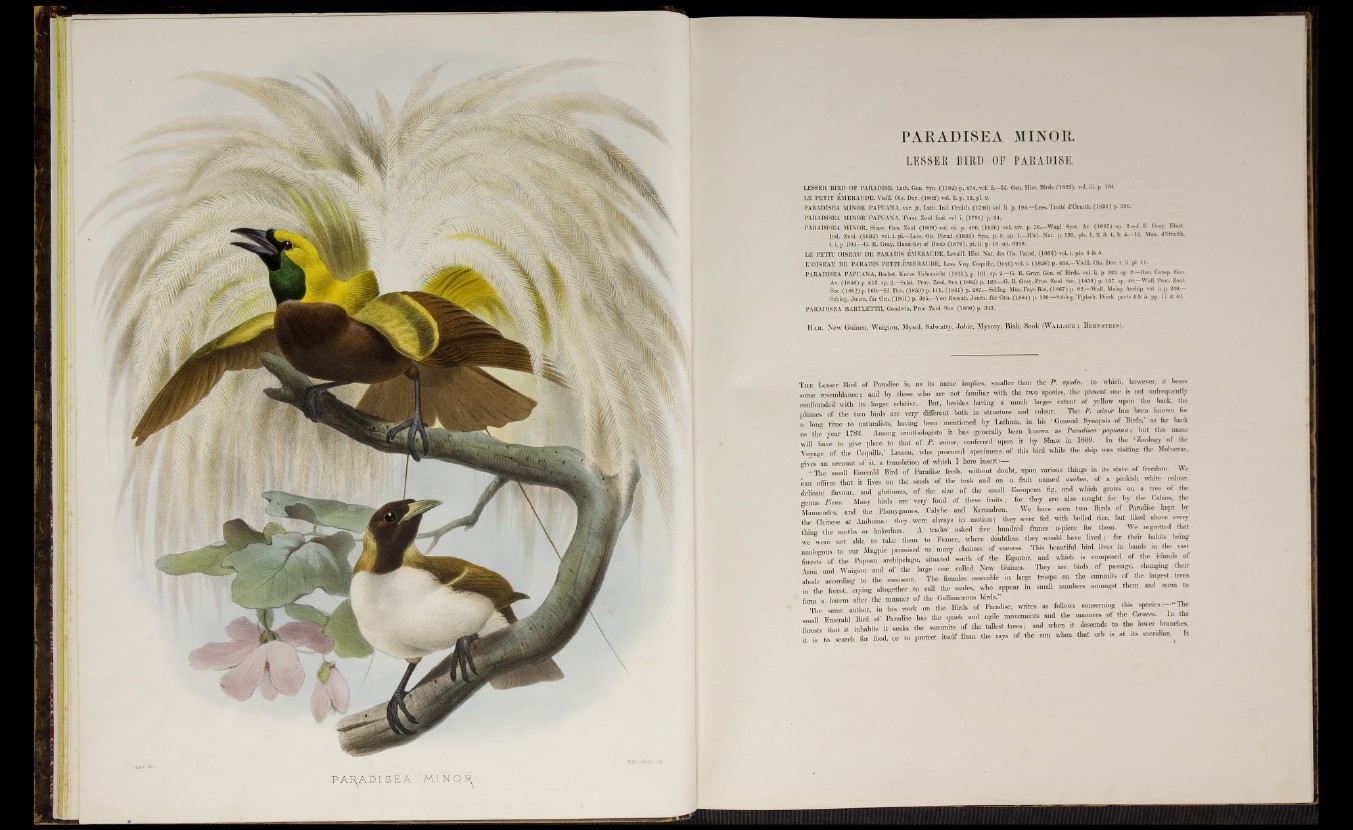
PAR^AD I S E A 'M IN O R
L E S S ER BIRD OF PARADISE.
LESSER BIRD OF PARADISE, Lath. Gen. Syn. (1782) p. 474, vol. ii— Id. Gen. H is t Birds (1822), vol. iii. p. 184.
LE PETIT ÉMERAUDE, VieilL Ois. Dor. (1802) vol. ü. p. 12, pi. 2.
PARADISEA MINOR PAPUANA, var. ß., Lath. Ind. Ornith. (1790) vol. ii. p. 19 4—Less. Traité d’Ornith. (1831) p. 336.
PARADISEA MINOR PAPUANA, Forst. Zool. Ind. vol. i. (1 781) p. 34.
PARADISEA MINOR, Shaw, Gen. Zool. (1809) vol. vii. p. 486, (1826) vol. xiv. p. 76.—Wagl. Syst. Av. (1827) sp. 2 .- J . E. Gray, Illust
Ind.. Zool. (1832) vol. i. pl.—Less. Ois. Parad. (1835) Syn. p. 3. sp. 1.—Hist. Nat. p. 132, pis. 1, 2, 3, 4, & 6.—Id. Man. d’Ornith.
t. i. pi-392.-—G. R. Gray, Hand-list of Birds (1870), pt, ii. p. 16. no. 6248.
LE PETIT OISEAU DE PARADIS ÉMERAUDE, Levaill. Hist. Nat. des Ois. Parad. (1806) vol. i. pis. 4 & 6.
L’OISEAU DE PARADIS PETIT-EMERAUDE, Less. Voy, Coquille, (text) vol. i. (1826) p. 654.—VieUl. Ois. Dor. t. ü. pi. 11.
PARADISEA PAPUANA, Bechst. Kurze Uebersicht (1811), p. 131. sp. 2.—G. R. Gray, Gen. of Birds, vol. ii. p. 323. sp. 2.—Bon. Consp. Gen.
Av. (1850) p. 413. sp. 2.—Sclat. Proc. Zool. Soc. (1862) p. 123.—G. R. Gray, Proc. Zool. Soc. (1859) p. 157. sp. 48.—Wall. Proc. Zool.
Soc. ( 1862) p. 160.—Id. Ibis, (1859) p. I l l , (1861) p. 287.—Schleg. Mus. Pays Bas, (1867) p. 82.—Wall. Malay Archip. vol. ii. p. 240.—
Schleg. Joum. für Om. (1861) p. 385.—Von Rosenb. Joum. für Om. (1864) p. 129.—Schleg. Tijdsch. Dierk. parts 4 & 5, pp. 17 & 49.
PARADISEA BARTLETTII, Goodwin, Proc. Zool. Soc. (1860) p. 243.
H a b . New Guinea, Waigiou, Mysol, Salwatty, Jobie, Mysory, Biak, Sook (W a l l a c e ; B e b n s t e in ).
T h e Leaser, Bird of Paradise is, as its name implies, smaller than the P. apoia, to wbieh, however, it bears
some resemblance; and by those who are mot familiar with the two species, the present one is not unfrequcntly
confounded with its larger relative.. But, besides having, a much larger ertent of yellow upon the back, the
plumes of the two birds are very different both in structure and, colour. The P. minor has been known for
a long time to naturalists, having been mentioned by Latham, in his ‘ General Synopsis of Birds, as far back
as-ithe year 1782. Among ornithologists it has generally been known as Parndisea papuana-, but this name
will have to give place to that of P. minor, conferred upon it by Shaw in 1809. In the ‘ Zoology of the
Voyage of the, Coquille,’ Lesson, who procured specimens of this bird while the ship was visiting the Moluccas,
gives an account of it, a translation of which I here insert;—
'•-The small. Emerald Bird of Paradise feeds, without doubt, upon various things in its state of freedom. We
¿an affirm that it lives on the seeds of the teak and on a fruit named armhon, of a pinkish white colour,
delicate flavour, and glutinous, of the size of the small European fig, and which grows on a tree of the
genus « cm Many birds are very fond of these fruits; for they are also sought for by the Calaos, *be
Manueodes, and the Phonygames, Calybe and Keraudren. We have seen two Birds of Paradise kept by
the Chinese at Amhoina; they were always in motion; they were fed with boiled rice, but liked above every
thins the moths or kakerlacs. A trader asked five hundred francs a-piece for them. We regretted that
we were not able to take them, to France, where doubtless they would have lived,- for their habits being
analogous to our Magpie promised us many chances of success. This beautiful bird lives m hands m the vast
forests of the Papuan archipelago, situated south of the Equator, and which is composed of the islands of
Aro.1 and Waigiou and of the large one called New Guinea.' They, are birds of passage, changmg then-
abode according- to the monsoon. The females assemble in large troops on the summits of the largest trees
in the forest, 'dying altogether to call the males, who appear in small numbers amongst them and seem to
I form a harem after the manner of the Gallinaceous birds.”
The same author, in his work on the Birds of Paradise, writes, as foflowa concemmg tin. s p e c . e s The
small Emerald Bird of Paradise has the quick and agile movements and the manners of the Coraces. In the
forests that it inhabits it seeks the summits of the tallest trees; and when it descends to the lower branch«*
it is to search for food, or to protect itself from the rays of the sun when that orb is at its meridian.^ It